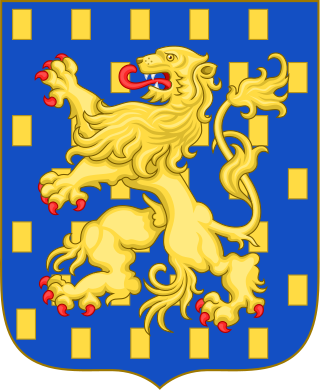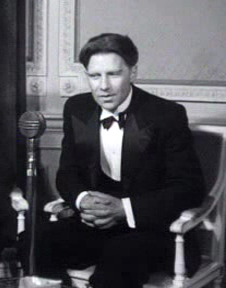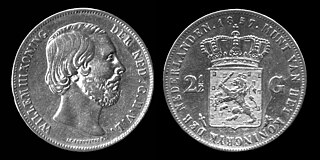
The House of Orange-Nassau is the current reigning house of the Netherlands. A branch of the European House of Nassau, the house has played a central role in the politics and government of the Netherlands and elsewhere in Europe, particularly since William the Silent organised the Dutch Revolt against Spanish rule, which after the Eighty Years' War (1568–1648) led to an independent Dutch state. William III of Orange led the resistance of the Netherlands and Europe to Louis XIV of France, and orchestrated the Glorious Revolution in England that established parliamentary rule. Similarly, Queen Wilhelmina of the Netherlands was instrumental in the Dutch resistance during World War II.

Willem-Alexander is King of the Netherlands.

Prince Constantijn of the Netherlands is the third and youngest son of the former Dutch queen, Beatrix, and her husband, Claus von Amsberg, and is the younger brother of the reigning Dutch king, Willem-Alexander. He is a member of the Dutch Royal House and currently fourth in the line of succession to the Dutch throne behind his nieces.

Prince of Orange is a title associated with the sovereign Principality of Orange, in what is now southern France and subsequently held by the stadtholders of, and then the heirs apparent of, the Netherlands.

Catharina-Amalia, Princess of Orange is the heir apparent to the throne of the Kingdom of the Netherlands, which consists of the constituent countries of Aruba, Curaçao, the Netherlands, and Sint Maarten.

The coat of arms of the Kingdom of the Netherlands was originally adopted in 1815 and later modified in 1907. The arms are a composite of the arms of the former Dutch Republic and the arms of the House of Nassau, it features a checkered shield with a lion grasping a sword in one hand and a bundle of arrows in the other and is the heraldic symbol of the monarch and the country. The monarch uses a version of the arms with a mantle while the government of the Netherlands uses a smaller version without the mantle (cloak) or the pavilion, sometimes only the shield and crown are used. The components of the coats of arms were regulated by Queen Wilhelmina in a royal decree of 10 July 1907, affirmed by Queen Juliana in a royal decree of 23 April 1980.

Princess Alexia of the Netherlands, Princess of Orange-Nassau is the second daughter of Willem-Alexander of the Netherlands and Queen Máxima of the Netherlands. Princess Alexia is a member of the Dutch royal house and second in the line of succession to the Dutch throne.

The House of Nassau is a diversified aristocratic dynasty in Europe. It is named after the lordship associated with Nassau Castle, located in present-day Nassau, Rhineland-Palatinate, Germany. With the fall of the Hohenstaufen in the first half of the 13th century royal power within Franconia evaporated and the former stem duchy fragmented into separate independent states. Nassau emerged as one of those independent states as part of the Holy Roman Empire. The lords of Nassau were originally titled "Count of Nassau", subject only to the Emperor, and then elevated to the princely class as "Princely Counts". Early on they divided into two main branches: the elder (Walramian) branch, that gave rise to the German king Adolf, and the younger (Ottonian) branch, that gave rise to the Princes of Orange and the monarchs of the Netherlands.

Vice-admiral Jonkheer Theodorus Frederik van Capellen, GCMWO, KCB was a Dutch naval officer. He was married to Petronella de Lange (1779–1835). Alexine Tinne, female explorer and pioneering photographer, was his granddaughter.

Justus van Maurik, was a Dutch author and cigar maker. He was the grandson of Justus van Maurik Sr.

Prince Bernhard of Lippe-Biesterfeld was Prince of the Netherlands from 6 September 1948 to 30 April 1980 as the husband of Queen Juliana. They had four daughters together, including Beatrix, who was Queen of the Netherlands from 1980 to 2013.

The study of Dutch heraldry focuses on the use of coats of arms and other insignia in the country of the Netherlands. Dutch heraldry is characterised by its simple and rather sober style, and in this sense, is closer to its medieval origins than the elaborate styles which developed in other heraldic traditions.

The monarchy of the Netherlands is a constitutional monarchy whose role and position are governed by the Constitution of the Netherlands. Roughly a third of the Constitution explains the succession, mechanisms of accession and abdication to the throne, the roles and duties of the monarch, the formalities of communication between the States General of the Netherlands, and the monarch's role in creating laws.

The Dutch Republic Lion was the badge of the Union of Utrecht, the Republic of the Seven United Netherlands, and a precursor of the current coat of arms of the Kingdom the Netherlands.

A. den Doolaard is the pseudonym of the Dutch writer and journalist Cornelis Johannes George (Bob) Spoelstra Jr.

The coat of arms of Hoorn is a coat of arms that has been in use since the Middle Ages. Although over time it underwent some changes, there has been no change to the coat of arms since it was acknowledged in use by the High Council of Nobility in 1816. At present, in the original form, it is the coat of arms of the municipality of Hoorn. The current municipality was formed in 1979 by merging the city of Hoorn with the villages Zwaag and Westerblokker; it was decided to use the old coat of arms as coat of arms of the new municipality.

The style of the Dutch sovereign has changed many times since the establishment of the Kingdom of the Netherlands due to formations and dissolutions of personal unions, as well as due to marriages of female sovereigns and cognatic successions.
This page shows the coats of arms, heraldic achievements, and heraldic flags of the House of Nassau.
Maria Johanna Francisca Renée "Noni" Lichtveld was a Dutch-Surinamese author, illustrator and scenic designer.
















